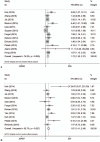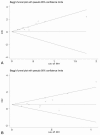Prognostic role of pretreatment neutrophil to lymphocyte ratio in breast cancer patients: A meta-analysis
- PMID: 29137007
- PMCID: PMC5690700
- DOI: 10.1097/MD.0000000000008101
Prognostic role of pretreatment neutrophil to lymphocyte ratio in breast cancer patients: A meta-analysis
Erratum in
-
Prognostic role of pretreatment neutrophil to lymphocyte ratio in breast cancer patients: A meta-analysis: Erratum.Medicine (Baltimore). 2018 Jan;97(4):e9727. doi: 10.1097/MD.0000000000009727. Medicine (Baltimore). 2018. PMID: 29369210 Free PMC article. No abstract available.
-
Prognostic role of pretreatment neutrophil to lymphocyte ratio in breast cancer patients: A meta-analysis: Erratum.Medicine (Baltimore). 2017 Dec;96(52):e9526. doi: 10.1097/MD.0000000000009526. Medicine (Baltimore). 2017. PMID: 29384963 Free PMC article. No abstract available.
Abstract
Background: Inflammation and cancer are closely related to each other. As a parameter that can reflect inflammation and host immune reaction, elevated blood neutrophil to lymphocyte ratio (NLR) has been confirmed to be correlated with poor prognosis in a variety of cancers. However, this remains controversial in breast cancer. Thus, we performed this updated meta-analysis to further clarify whether high NLR could be a predictor of survival in breast cancer patients.
Methods: We searched on PubMed Database and Cochrane Library. Overall survival (OS), disease-free survival (DFS), and cancer-specific survival were used as outcome events, and hazard ratio (HR) was chosen as the parameter to evaluate the correlation.
Result: Eighteen eligible studies were involved in this meta-analysis. The synthesized analysis demonstrated that elevated NLR was associated with poor DFS [HR = 1.72, 95% confidence interval (95% CI) = 1.30-2.27], OS (HR = 1.87, 95% CI = 1.41-2.48), and cancer-specific survival (HR = 2.09, 95% CI = 1.04-4.21). The correlation was stronger in triple-negative breast cancer (TNBC) (OS: HR = 2.58, 95% CI = 1.63-4.06; DFS: HR = 3.51, 95% CI = 1.97-6.24).
Conclusion: Higher NLR was correlated to poor prognosis of breast cancer patients. As a clinical parameter that we can easily obtain, NLR might be a potential predictor in patients' survival to assist with physicians' treatment decisions.
Conflict of interest statement
The authors report no conflicts of interest.
Figures




Similar articles
-
Prognostic value of neutrophil-to-lymphocyte ratio for patients with triple-negative breast cancer: A meta-analysis.Medicine (Baltimore). 2022 Jul 15;101(28):e29887. doi: 10.1097/MD.0000000000029887. Medicine (Baltimore). 2022. PMID: 35839045 Free PMC article.
-
The Peripheral Blood Neutrophil-To-Lymphocyte Ratio Is Superior to the Lymphocyte-To-Monocyte Ratio for Predicting the Long-Term Survival of Triple-Negative Breast Cancer Patients.PLoS One. 2015 Nov 18;10(11):e0143061. doi: 10.1371/journal.pone.0143061. eCollection 2015. PLoS One. 2015. PMID: 26580962 Free PMC article.
-
Prognostic value of neutrophil-to-lymphocyte ratio and platelet-to-lymphocyte ratio for breast cancer patients: An updated meta-analysis of 17079 individuals.Cancer Med. 2019 Aug;8(9):4135-4148. doi: 10.1002/cam4.2281. Epub 2019 Jun 13. Cancer Med. 2019. PMID: 31197958 Free PMC article.
-
Prognostic Significance of Pretreatment Neutrophil-to-Lymphocyte Ratio, Platelet-to-Lymphocyte Ratio, or Monocyte-to-Lymphocyte Ratio in Endometrial Neoplasms: A Systematic Review and Meta-analysis.Front Oncol. 2022 May 16;12:734948. doi: 10.3389/fonc.2022.734948. eCollection 2022. Front Oncol. 2022. PMID: 35651788 Free PMC article.
-
Prognostic value of pretreatment neutrophil-to-lymphocyte ratio in renal cell carcinoma: a systematic review and meta-analysis.BMC Urol. 2020 Jul 6;20(1):90. doi: 10.1186/s12894-020-00665-8. BMC Urol. 2020. PMID: 32631294 Free PMC article.
Cited by
-
In Early Breast Cancer, the Ratios of Neutrophils, Platelets and Monocytes to Lymphocytes Significantly Correlate with the Presence of Subsets of Circulating Tumor Cells but Not with Disseminated Tumor Cells.Cancers (Basel). 2022 Jul 6;14(14):3299. doi: 10.3390/cancers14143299. Cancers (Basel). 2022. PMID: 35884360 Free PMC article.
-
Association of neutrophil-to-lymphocyte ratio with clinical, pathological, radiological, laboratory features and disease outcomes of invasive breast cancer patients: A retrospective observational cohort study.Medicine (Baltimore). 2023 May 19;102(20):e33811. doi: 10.1097/MD.0000000000033811. Medicine (Baltimore). 2023. PMID: 37335707 Free PMC article.
-
Neutrophil-to-lymphocyte ratio predicts early mortality in females with metastatic triple-negative breast cancer.PLoS One. 2020 Dec 7;15(12):e0243447. doi: 10.1371/journal.pone.0243447. eCollection 2020. PLoS One. 2020. PMID: 33284847 Free PMC article.
-
Significance of baseline neutrophil-to-lymphocyte ratio for progression-free survival of patients with HER2-positive breast cancer treated with trastuzumab emtansine.Sci Rep. 2019 Feb 12;9(1):1811. doi: 10.1038/s41598-018-37633-0. Sci Rep. 2019. PMID: 30755651 Free PMC article.
-
Prognostic role of pretreatment neutrophil to lymphocyte ratio in breast cancer patients: A meta-analysis: Erratum.Medicine (Baltimore). 2018 Jan;97(4):e9727. doi: 10.1097/MD.0000000000009727. Medicine (Baltimore). 2018. PMID: 29369210 Free PMC article. No abstract available.
References
-
- Chen W, Zheng R, Baade PD, et al. Cancer statistics in China, 2015. CA Cancer J Clin 2016;66:115–32. - PubMed
-
- Siegel RL, Miller KD, Jemal A. Cancer statistics, 2015. CA Cancer J Clin 2015;65:5–29. - PubMed
-
- Allen MD, Jones LJ. The role of inflammation in progression of breast cancer: friend or foe? (Review). Int J Oncol 2015;47:797–805. - PubMed
Publication types
MeSH terms
LinkOut - more resources
Full Text Sources
Other Literature Sources
Medical
Research Materials

